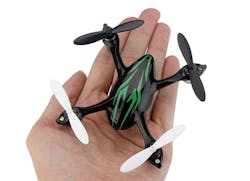Army eyes hand-launched squad drone the weight of a baseball for battlefield surveillance
Officials of the Army Contracting Command at Aberdeen Proving Ground, Md., issued a request for information (W91CRBRequestforInformation) earlier this month for the Soldier Borne Sensors (SBS) program to develop a personal battlefield surveillance drone for Army infantry.
The entire system consisting of control console, display, and unmanned aircraft will weigh about 3 pounds, and the actual drone aircraft will weigh about 150 grams (5.29 ounces). One warfighter will be able to operate the drone by himself, and the drone will work during the day, at night, and in light rain.
The Army Contracting Command is issuing its request for information on behalf the Army's Product Manager Soldier Maneuver Sensors (PM SMS) within the Army's Program Executive Office (PEO) Soldier.
Related: Army asks Norwegian company to design Black Hornet pocket UAV helicopter for foot soldiers
Army researchers will brief industry on the program's objectives from 1 to 5 p.m. on 12 April 2016 during a virtual industry day to address enabling technologies that support the ability of the infantry squad to obtain real-time actionable information out of the range of contact. An Army squad has 8 to 24 warfighters.
The stand-alone system will have all hardware, software, radio equipment, batteries, and a tactical carrying pouch and is to be flown by one operator; display incoming video and telemetry data in near real time during the day, at night, and in light precipitation.
The system will be able to return to a predetermined location if it loses its radio link; have a display that is during the day and at night; accept standard battery charging; have an unmanned aircraft able to fly in manual mode and by waypoint navigation; and have an operating radius of 500 meters for 15 minutes.
The system's display must have sufficient resolution for a trained operator to detect a man-sized target with a 90-percent probability; and have a UAV that can be launched and recovered by hand while the operator is lying down under cover. The operator must be able to set up the system and launch the UAV within 60 seconds, and the UAV must be able to fly reliably in 10-knot winds with gusts to 15 knots.
Related: The coming age of the military micro-drone
Companies interested should email two-page information papers and initial questions no later than this Friday, 18 March 2016 to the Army's Sarah Coleman at [email protected].
For questions or concerns, or to learn how to attend the virtual industry day briefings, contact the Army's Leo Sydlink by email at [email protected], or by phone at 410-278-2414.
More information is online at https://www.fbo.gov/notices/f958d13185cc0d905a33e4922ebc173f.
